
Authors: Hongwei Hsiao, Rui Li, Mengying Zhang, Guowen Song
Date: December 03, 2025
Despite recent updates to the NFPA standard for firefighter glove sizing, significant fit and coverage challenges persist due to gaps in data application and design translation. This study assessed the standard's ability to accommodate the firefighter population, examined optimal size gradations, and proposed an improved sizing scheme. Using 12 hand measurements from a stratified sample of 943 firefighters, the analysis employed data mapping, principal component analysis (PCA), clustering, and logistic regression. Results showed that 35.2 % of firefighter hands fall outside the seven required NFPA sizes. A refined seven-size system was developed using PCA and clustering, while preserving NFPA sizing conventions. Logistic regression established probability-based boundaries to better guide size selection for users. This study offers the most up-to-date analysis of glove sizing alternatives, providing hand-dimension specifications to help manufacturers optimize design, streamline production, reduce inventory complexity, and enhance glove accommodation for firefighters.
Authors: Saloni Purandare, Rui Li, Chunhui Xiang, Guowen Song
Date: November 30, 2025

Antimicrobial function in protective and medical textiles is an essential safety feature since textiles can become breeding grounds for microorganisms. Ideally, the antimicrobial function in textiles should be non-toxic, stable, and durable. This study explores a core–shell nanofiber with a core of the cationic biopolymer ε-poly-L-lysine (PL) and shell of structurally similar and biocompatible polyamide-6 (PA). The core–shell structure is expected to have a more stable antimicrobial function than its monolithic counterpart. Further, thermal crosslinking is expected to prevent rapid diffusion of the water-soluble PL. Therefore, this study establishes a comparison between a monolithic (control), a core–shell (CS), and a thermally crosslinked core–shell (CL-CS) nanofiber of PL and PA. Morphological analysis confirmed the successful generation of the core–shell nanofibers. All the samples exhibited hydrophilic behavior and antimicrobial function. However, the control sample showcased significantly reduced zones of inhibition in antimicrobial testing with 21 days of bacterial exposure (1.027 ± 0.072 cm2), as compared to 24 h bacterial exposure (1.347 ± 0.151 cm2). On the other hand, the zones of inhibition for 24 h vs. 21 days for CS (1.265 ± 0.042 cm2 vs. 1.052 ± 0.235 cm2) and CL-CS (1.128 ± 0.161 cm2 vs. 1.106 ± 0.047 cm2) showed no significant differences. Therefore, the core–shell structure allowed for sustainable and durable antimicrobial action. Lastly, the CL-CS sample exhibited reusable antimicrobial function owing to the core–shell structure paired with thermal crosslinking. This study showcases a fiber system with non-toxic, durable, and reusable antimicrobial function. This study builds grounds for the development and multifaceted holistic characterization of safe, stable, and scalable antimicrobial textiles.
Authors: Fan Zhou, Mengying Zhang, Yulin Wu, Jie Yang, Sixing Yu, Ali Jannesair, Guowen Song
Date: November 2, 2025
Optimizing thermal comfort for gloves requires precise predictions of localized thermal resistance (Rct), yet traditional experimental methods are costly and limited in capturing complex interactions. This study developed a computational framework employing Bayesian-optimized machine learning models, including multiple linear regression (MLR), decision tree (DT), generalized additive model (GAM), support vector regression (SVR), and deep learning (DL), to predict localized Rct of firefighting gloves. Utilizing 1680 measurements from firefighting gloves, predictive accuracy and stability were evaluated. DL demonstrated the highest predictive accuracy (R² = 0.924690, mean absolute error [MAE] = 0.009970), closely followed by SVR (R² = 0.913098, MAE = 0.011209) and GAM (R² = 0.909959, MAE = 0.011472), whereas DT and MLR exhibited lower accuracy. Response surface analysis revealed that GAM provides consistent and interpretable predictions in sparse data contexts; DL captures detailed, complex interactions but requires careful management of potential overfitting; SVR represents an intermediate choice, balancing nonlinear accuracy with smoothness but still vulnerable to occasional nonphysical predictions in sparse data scenarios. Key predictors were air layer thickness, glove thickness, wind speed, glove section, and surface area. Thermal resistance increased consistently with air layer thickness, whereas higher wind speeds reduced insulation. Predictions highlighted the little finger as the most critical region, with Rct decreasing from 0.145 to 0.112 K m2/W as the wind speed increased from 0 to 2 m/s. Future studies should incorporate experimental validation under realistic firefighting scenarios, expand dataset diversity, and apply physically constrained models to enhance prediction robustness.
Authors: Md Jalal Uddin Rumi, Yulin Wu, Mengying Zhang, Rui Li, Guowen Song
Date: October 9, 2025

Objective: This review synthesizes atmospheric chemistry, toxicology, and environmental justice to assess public health risks from ultrafine particles (UFPs, <100 nm) in Wildland-Urban Interface (WUI) fire smoke. It explores UFP emission sources, transformation dynamics, exposure pathways, and disproportionate impacts on vulnerable populations, while evaluating advanced characterization methods and identifying knowledge gaps and formulating systematic future research directions.
Main Finding: WUI fires, driven by climate change and urban expansion, produce UFPs accounting for 77–90 % of particle number concentrations (up to 1.25 × 10⁵ particles/cm³) and 11.7–31.4 % of particulate mass, enriched with polycyclic aromatic hydrocarbons (PAHs), heavy metals (0.01–1 μg/m³), and per- and polyfluoroalkyl substances from synthetic materials (e.g., plastics, batteries). Photochemical aging generates secondary organic aerosols and ozone, heightening toxicity. Techniques like high-angle annular dark-field scanning transmission electron microscopy (~10 nm resolution) and high-resolution time-of-flight aerosol mass spectrometry clarify UFP properties, while machine learning enhances exposure modeling using satellite and ground data. UFPs breach biological barriers, causing oxidative stress and inflammation, with an 87 % asthma prevalence increase and elevated cardiovascular, neurological, and carcinogenic risks, disproportionately affecting low-income, indigenous groups, and firefighters due to systemic inequities.
Knowledge Gaps: Critical gaps include standardized real-time UFP monitoring, poor understanding of aging dynamics, incomplete emission profiles from mixed fuels, and insufficient data on UFP-PAH toxicity and heavy metal emissions from electric vehicles (EVs) involved in WUI fires.
Implications: This review advocates enhanced real-time monitoring and systematic future research directions to unveil the risks of UFPs from WUI Fires and mitigate WUI fire smoke impacts.
Authors: B. Hashemian Esfahani, R. Li, M. Zhan, R. Eike, M. Etemadzadeh, G. Song
Date: August 8, 2025

Bahar Hashemian Esfahani and colleagues published a review article in Textile Progress addressing fundamental limitations in current firefighter hoods and opening new possibilities for safer, higher-performance protective gear that meets the extreme demands of firefighting operations. Alongside Dr. Rui Li, Dr. Mengying Zhang, Dr. Rachel Eike, Mazyar Etemadzadeh, and Dr. Guowen Song, Bahar presents insights into current protective textile technology with direct applications for firefighter safety. The research addresses the historical shortcomings of traditional designs that left firefighters vulnerable to carcinogenic smoke exposure by addressing advancements in particulate-blocking hoods-new standards set by the National Fire Protection Association. Through rigorous analysis, the team has identified key challenges in balancing protection with wearer comfort, particularly regarding heat stress, mobility restrictions, and ergonomic fit. The study emphasizes the necessity of integrated testing approaches that combine laboratory assessments with real-world performance evaluations, especially concerning hood compatibility with other PPE components like helmets and breathing apparatus. These findings provide valuable insights for PPE manufacturers, fire safety researchers, and policymakers working to develop next-generation protective gear that reduces long-term health risks while optimizing operational performance.
Development of Innovative Composite Nanofiber: Enhancing Polyamide-6 with ε-Poly-L-Lysine for Medical and Protective Textiles
Authors: Saloni Purandare, Rui Li, Chunhui Xiang, Guowen Song
July 17, 2024
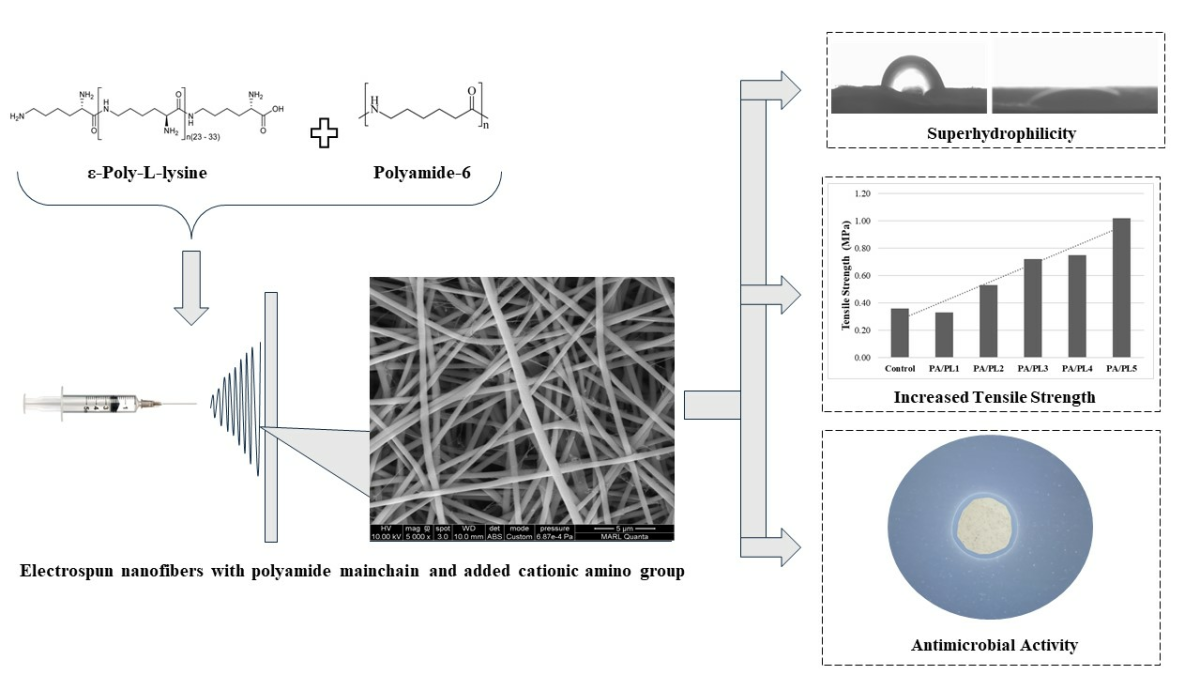
Polyamide-6 (PA) is a popular textile polymer having desirable mechanical and thermal properties, chemical stability, and biocompatibility. However, PA nanofibers are prone to bacterial growth and user discomfort. ε-Poly-L-lysine (PL) is non-toxic, antimicrobial, and hydrophilic but lacks spinnability due to its low molecular weight. Given its similar backbone structure to PA, with an additional amino side chain, PL was integrated with PA to develop multifunctional nanofibers. This study explores a simple, scalable method by which to obtain PL nanofibers by utilizing the structurally similar PA as the base. The goal was to enhance the functionality of PA by addressing its drawbacks. The study demonstrates spinnability of varying concentrations of PL with base PA while exploring compositions with higher PL concentrations than previously reported. Electrospinning parameters were studied to optimize the nanofiber properties. The effects of PL addition on morphology, hydrophilicity, thermal stability, mechanical performance, and long-term antimicrobial activity of nanofibers were evaluated. The maximum spinnable concentration of PL in PA-based nanofibers resulted in super hydrophilicity (0° static water contact angle within 10 s), increased tensile strength (1.02 MPa from 0.36 MPa of control), and efficient antimicrobial properties with long-term stability. These enhanced characteristics hold promise for the composite nanofiber’s application in medical and protective textiles.
Designing Advanced Respiratory Protective Devices for Pandemics: Performance, Mechanism and Future Perspectives
Authors: Rui Li, Guowen Song
February 16, 2024
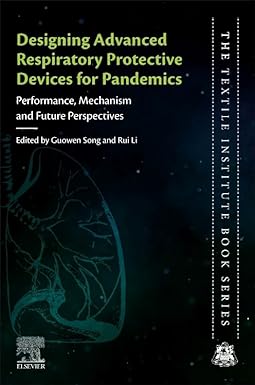
Designing Advanced Respiratory Protective Devices for Pandemics: Performance, Mechanism and Future Perspectives identifies emerging and critical issues that directly or indirectly influence the protective performance of Respiratory Protective Devices (RPDs), along with important future research directions. The severity of the COVID-19 pandemic emphasizes the vital role of respiratory protection provided by PPE (and RPD) in novel infectious respiratory disease control. A wealth of recent research on coronavirus mitigation measures is combined with prior information on infectious diseases, RPDs, and human physiological and psychological responses to make this a fundamental resource on recent advances, innovative perspectives on respiratory protection, and new applications. The effectiveness of such disease control measures rely greatly on the performance of the RPD, user compliance, and proper use. Only an interdisciplinary approach to this issue can lead to success.
- Combines introductory material on the nature of infectious disease and mechanisms of respiratory protection with cutting-edge research
- Examines the different material properties that lead to successful RPDs, including breathability, comfort, and recyclability
- Explains different methods for RPD test, evaluation, and approval from regulatory agencies worldwide
Analysis of glove local microclimate properties for various glove types and fits using 3D scanning method
Authors: Ankit Joshi, Rui Li, Yulin Wu, Mengying Zhang, Guowen Song
January 15, 2024
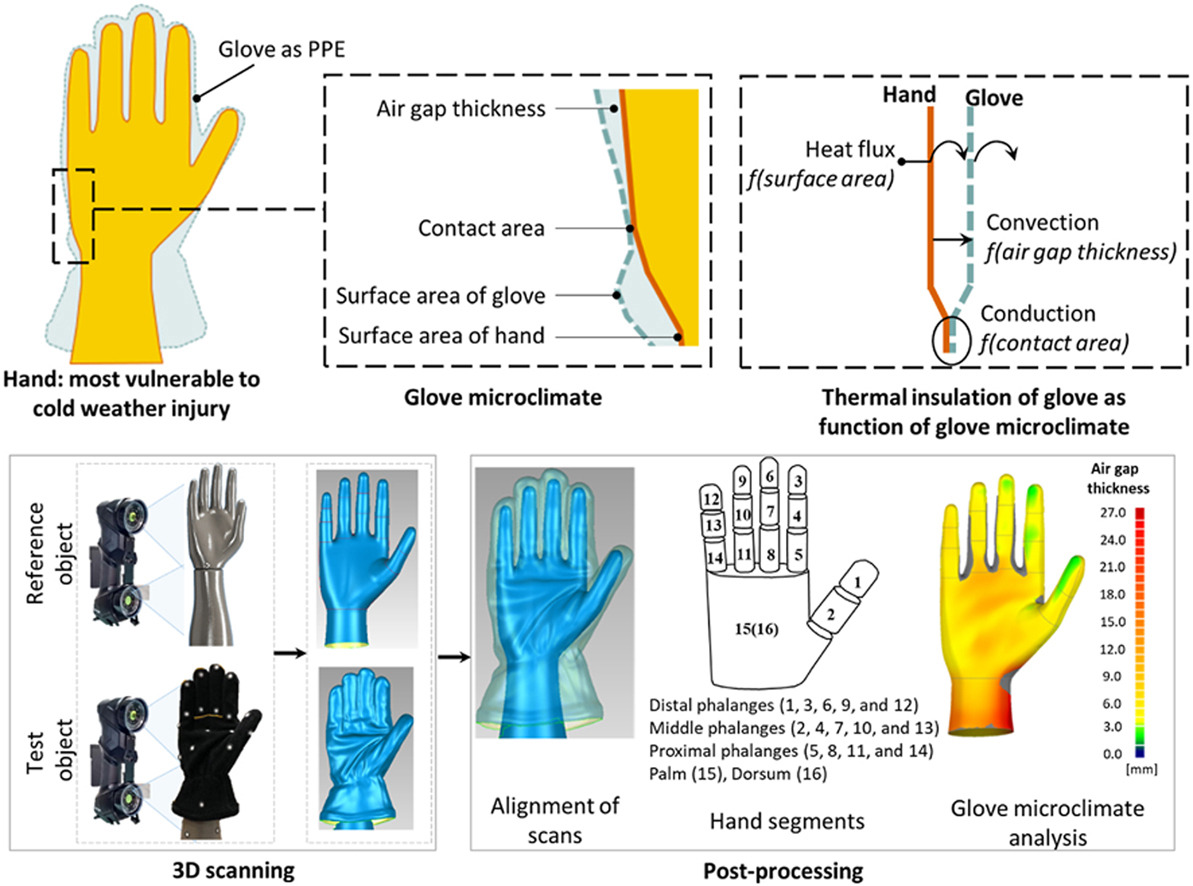
Due to their geometry and thermal physiology, hands are most vulnerable to cold weather injuries and loss of dexterity. Gloves are the most common for hand protection during exposure to extreme thermal and hazardous environments. Although glove microclimate properties such as area factor, air gap thickness, and contact area play a significant role in thermal protection, identifying local (at individual hand segments) glove microclimate properties is still a research gap. For the first time, the glove-microclimate properties for 16 hand segments at high spatial resolution were analyzed by employing state-of-the-art hand-held 3D scanner and post-processing techniques for different glove types. Our results clearly indicate that the glove area factor for distal phalanges is significantly higher (by 49.8 %) than that for other hand segments, which increases the heat transfer from distal phalanges. In contrast, average air gap thickness was relatively uniform across all hand segments. The glove type had a pronounced effect on glove microclimate properties, e.g., bulky and heavy cold weather protective gloves had a larger average air gap thickness and glove area factor. Regression models are also developed to estimate the glove microclimate properties from simple measurement (i.e., ease allowance).
How Artificial Intelligence May Solve the Glove Sizing Problem
Author: Mengying Zhang, Rui Li, Guowen Song
January 12, 2024
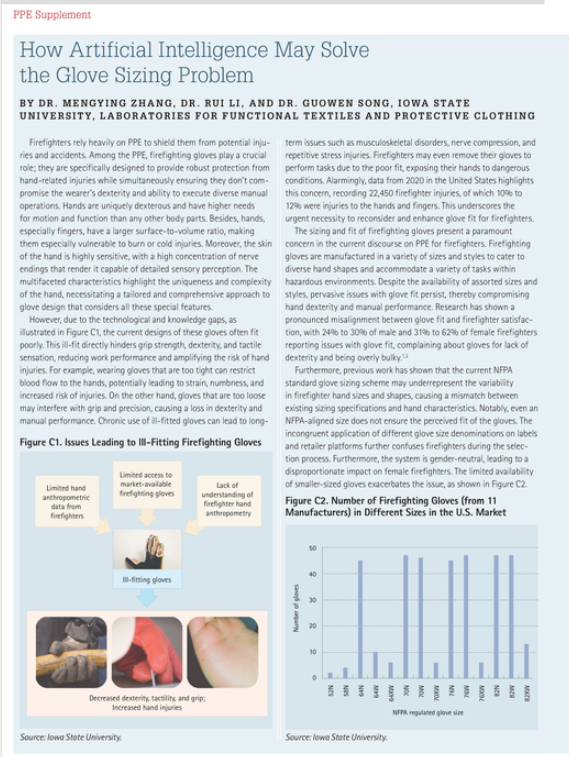
Firefighters rely heavily on PPE to shield them from potential injuries and accidents. Among the PPE, firefighting gloves play a crucial role; they are specifically designed to provide robust protection from hand-related injuries while simultaneously ensuring they don’t compromise the wearer’s dexterity and ability to execute diverse manual operations. Hands are uniquely dexterous and have higher needs for motion and function than any other body parts. Besides, hands, especially fingers, have a larger surface-to-volume ratio, making them especially vulnerable to burn or cold injuries. Moreover, the skin of the hand is highly sensitive, with a high concentration of nerve endings that render it capable of detailed sensory perception. The multifaceted characteristics highlight the uniqueness and complexity of the hand, necessitating a tailored and comprehensive approach to glove design that considers all these special features.
However, due to the technological and knowledge gaps, as illustrated in Figure C1, the current designs of these gloves often fit poorly. This ill-fit directly hinders grip strength, dexterity, and tactile sensation, reducing work performance and amplifying the risk of hand injuries. For example, wearing gloves that are too tight can restrict blood flow to the hands, potentially leading to strain, numbness, and increased risk of injuries. On the other hand, gloves that are too loose may interfere with grip and precision, causing a loss in dexterity and manual performance. Chronic use of ill-fitted gloves can lead to longterm issues such as musculoskeletal disorders, nerve compression, and repetitive stress injuries. Firefighters may even remove their gloves to perform tasks due to the poor fit, exposing their hands to dangerous conditions. Alarmingly, data from 2020 in the United States highlights this concern, recording 22,450 firefighter injuries, of which 10% to 12% were injuries to the hands and fingers. This underscores the urgent necessity to reconsider and enhance glove fit for firefighters.
Thermoregulation of human hands in cold environments and its modeling approach: A comprehensive review
Authors: Mengying Zhang, Rui Li, Yulin Wu, Guowen Song
December 3, 2023
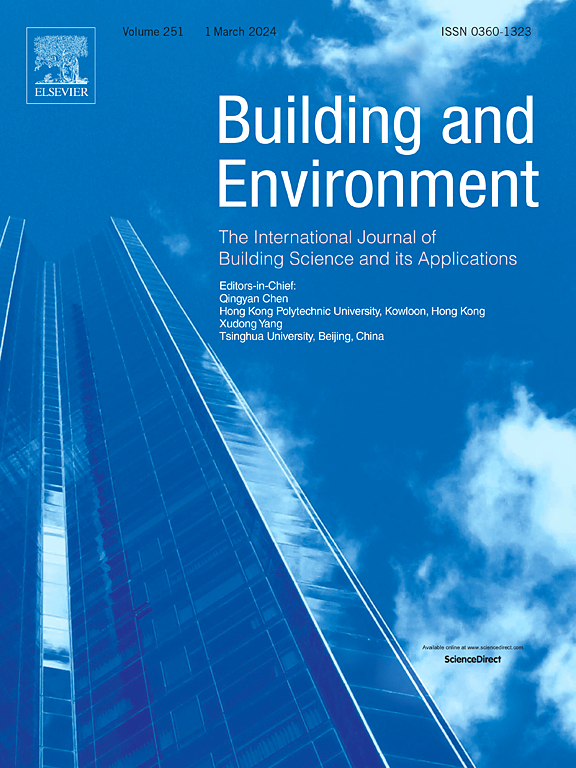
Cold environments pose significant risks to human health, well-being, and productivity, with hands being particularly vulnerable to cold stress and injuries. Mathematical models of hand thermoregulation have emerged as valuable tools for understanding and predicting hand performance and injuries, especially in extreme cold environments. While significant progress has been made in mathematical modeling, a systematic review of these models is currently lacking. This paper aims to fill this knowledge gap by conducting a comprehensive review of the existing literature on hand thermoregulation models in cold environments. It begins with an introduction to the unique thermophysical and thermophysiological characteristics of the hand. It then summarizes the historical evolution of hand thermoregulation models. The essential principles for developing hand-specific thermoregulation models are outlined, encompassing modeling of hand anatomy and geometry, thermophysiological responses, and heat transfer between the hand and its surroundings. This review presents prediction methods for cold injuries and hand performance. The need for future advancements in hand thermoregulation modeling is emphasized. Specifically, achieving a more realistic representation of hand anatomy and geometry, as well as incorporating location-dependent thermophysical properties and physiological behaviors of the hand, are identified as crucial areas for improvement to enhance prediction accuracy. This review will contribute to a deeper understanding of hand thermoregulation mechanisms and their interaction with cold environments, as well as the development of more reliable and applicable models.
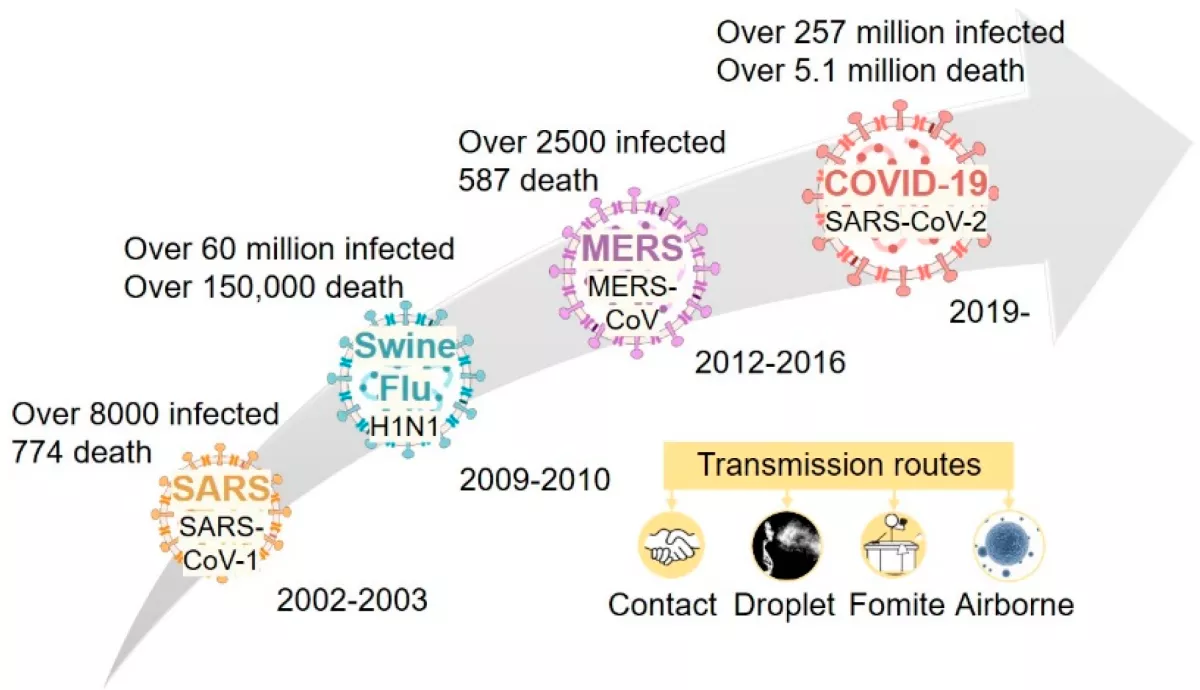
Infectious respiratory diseases such as the current COVID-19 have caused public health crises and interfered with social activity. Given the complexity of these novel infectious diseases, their dynamic nature, along with rapid changes in social and occupational environments, technology, and means of interpersonal interaction, respiratory protective devices (RPDs) play a crucial role in controlling infection, particularly for viruses like SARS-CoV-2 that have a high transmission rate, strong viability, multiple infection routes and mechanisms, and emerging new variants that could reduce the efficacy of existing vaccines. Evidence of asymptomatic and pre-symptomatic transmissions further highlights the importance of a universal adoption of RPDs. RPDs have substantially improved over the past 100 years due to advances in technology, materials, and medical knowledge.
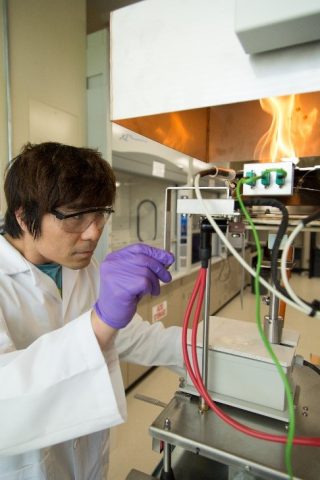
All building materials must meet a specific test standard in order to move forward with manufacturing. This standard, the ASTM-E84 Standard Test Method for Surface Burning Characteristics of Building Materials, is used to determine how various materials act upon ignition. It is a costly, complex, and large-scale standard that has been the norm. However, a new method has been introduced, and it’s shaking up how the E84 test is run.
The cone calorimeter is the most widely used instrument to study fire behavior of materials because it provides abundant information with relatively small sized samples. They are rarely found in the United States, but the Laboratories for Functional Textiles and Protective Clothing (LABS) at Iowa State University have acquired one and are looking for building material, furniture material, and insulation material manufacturers who may be interested in a cone calorimeter’s expedited testing capabilities.
Because of the large scale and complexity of the E84, the cone calorimeter can use less of the same material to inform the possibility of passing. This process will save time, resources, and expenses while trying alternative fire retardants for the best performance before attempting the E84 standard.
“Our lab can conduct tests according to many standards,” says lab manager Dr. Rui Li, “but we aren’t certified to provide a certification to the customer. So, we are best suited to offer pre-standard test assurance and customized test services for research and development purposes.”
For more information about the cone calorimeter and other test capabilities offered by LABS, contact Dr. Rui Li at ruili@iastate.edu or visit the LABS website at https://aeshm.hs.iastate.edu/current-students/facilities/laboratories-for-functional-textiles-and-protective-clothing/
PPE Books Published
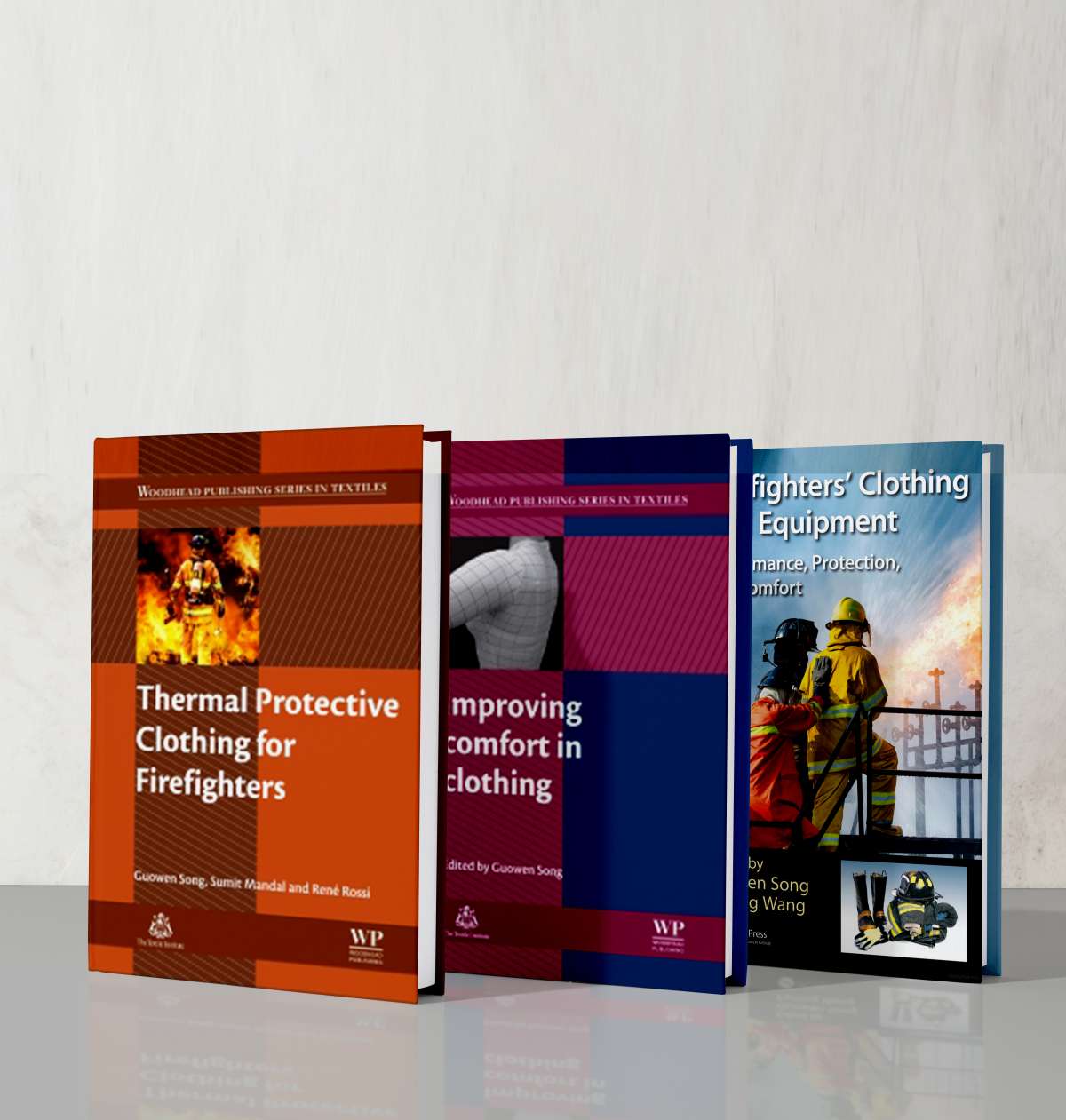
Thermal Protective Clothing for Firefighters explores every facet of the construction and use of thermal protective clothing. Everything from the high-performance design to testing methods and the key issues currently being examined by current and future research.
Improving Comfort in Clothing explores the most important property of clothing demanded by users and consumers according to recent studies: comfort.
This book outlines the foundations of human comfort in clothing, how to improve comfort, and reviews methods of improving comfort while maintaining function.
Firefighter’s Clothing and Equipment provides a complete overview of firefighters’ protective clothing, addresses the performance in terms of protection and comfort, and explores the ways we may improve for the future.